2023年中考英语知识点梳理表格版演示课件(主谓一致)(含19张PPT)
文档属性
| 名称 | 2023年中考英语知识点梳理表格版演示课件(主谓一致)(含19张PPT) |  | |
| 格式 | pptx | ||
| 文件大小 | 155.0KB | ||
| 资源类型 | 试卷 | ||
| 版本资源 | 通用版 | ||
| 科目 | 英语 | ||
| 更新时间 | 2023-03-23 18:33:19 | ||
图片预览

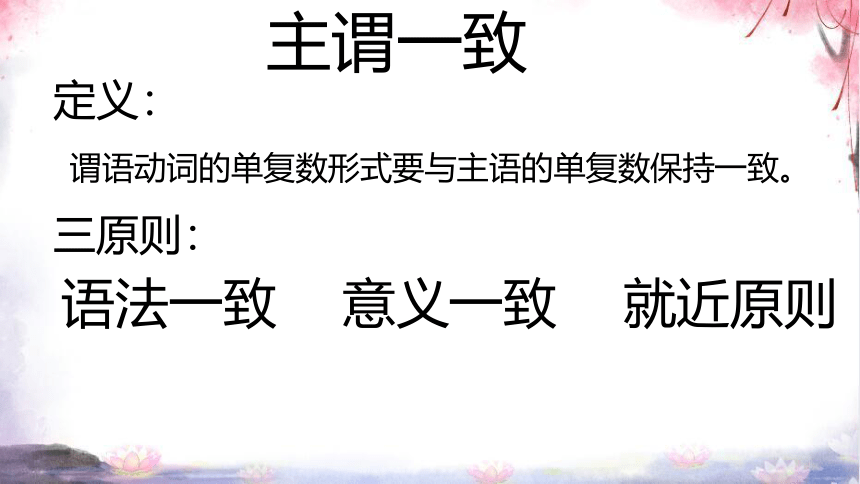
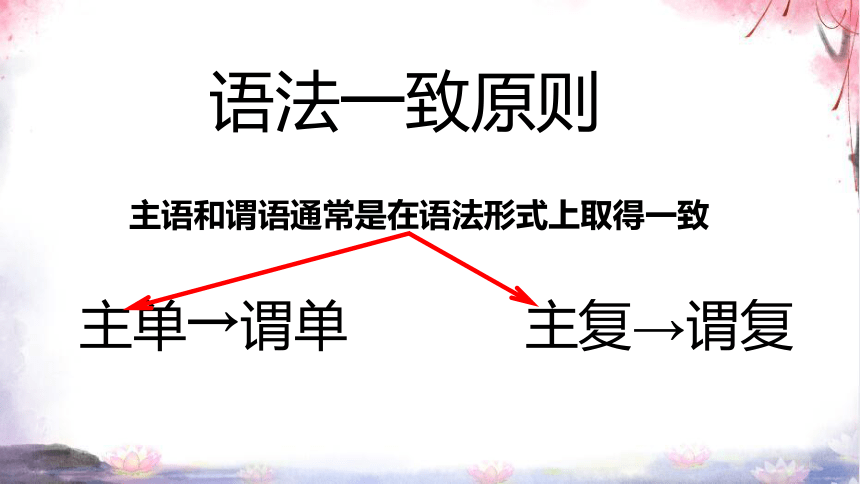
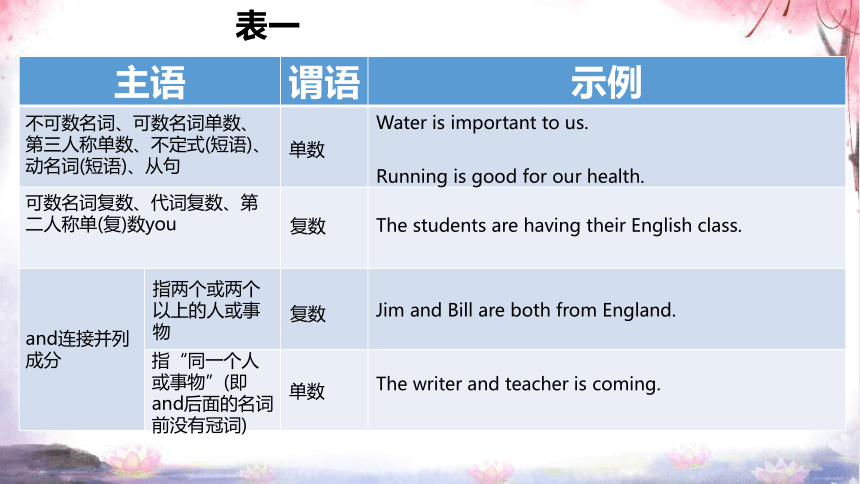
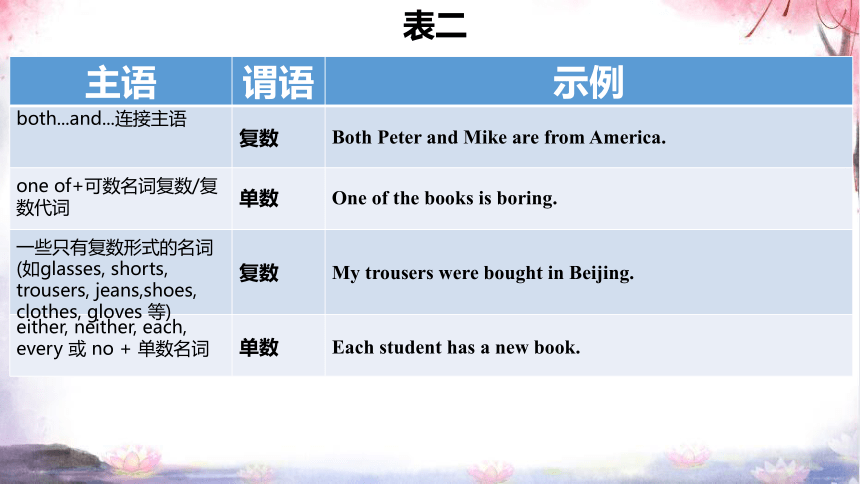
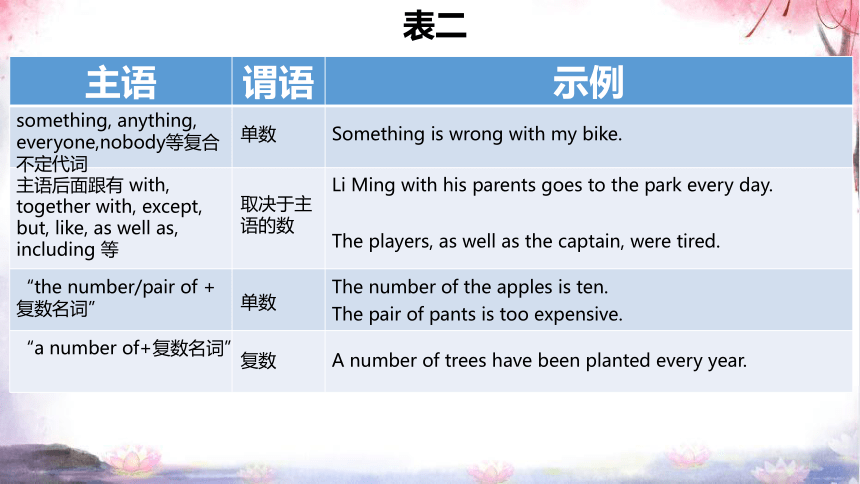

文档简介
(共19张PPT)
2023年中考考点梳理
表格版演示课件
(主谓一致)
谓语动词的单复数形式要与主语的单复数保持一致。
主谓一致
定义:
三原则:
语法一致
意义一致
就近原则
主语和谓语通常是在语法形式上取得一致
语法一致原则
主单→谓单
主复→谓复
表一
主语 谓语 示例
不可数名词、可数名词单数、第三人称单数、不定式(短语)、动名词(短语)、从句
可数名词复数、代词复数、第二人称单(复)数you
and连接并列成分
单数
复数
指两个或两个以上的人或事物
指“同一个人或事物”(即and后面的名词前没有冠词)
Water is important to us.
Running is good for our health.
The students are having their English class.
Jim and Bill are both from England.
The writer and teacher is coming.
复数
单数
主语 谓语 示例
表二
both...and...连接主语
one of+可数名词复数/复数代词
一些只有复数形式的名词(如glasses, shorts, trousers, jeans,shoes, clothes, gloves 等)
either, neither, each, every 或 no + 单数名词
复数
单数
复数
单数
Both Peter and Mike are from America.
One of the books is boring.
My trousers were bought in Beijing.
Each student has a new book.
主语 谓语 示例
表二
something, anything, everyone,nobody等复合不定代词
主语后面跟有 with, together with, except, but, like, as well as, including 等
“the number/pair of +复数名词”
“a number of+复数名词”
单数
取决于主语的数
单数
复数
Something is wrong with my bike.
Li Ming with his parents goes to the park every day.
The players, as well as the captain, were tired.
The number of the apples is ten.
The pair of pants is too expensive.
A number of trees have been planted every year.
主语 谓语 示例
表三
分数/百分数 +of + 名词
lots of/a lot of/plenty of/the rest of + 名词
“more +可数名词复数+ than one
取决于of后名词的数
复数
One third of the workers here are men.
A lot of books are in the room.
More members than one are against your plan.
谓语动词是单数还是复数要看主语所表达的概念。
意义一致原则
主语所表达的意义决定了谓语动词的单复数形式。
主语 谓语 示例
表一
集体名词(如 crowd, family, team, group, government, class, staff,public)
表示一个集体单位
表示集体中的成员
集体名词如 people, police,cattle等,形式上是单数,而意义上却表示复数
news,means, physics, politics 等词形式上是复数,而意义上却表示单数
单数
复数
复数
单数
This team plays better than that one.
The family are watching TV now.
The police are looking for the second car.
I think physics is very difficult.
主语 谓语 示例
表二
“the +形容词”表示一类人
“the+姓氏名词复数”表示“xx一家人;xx夫妇”
表示重量、度量、时间、长度、价格、数学运算等的词或短语作主语时,通常视为一个整体
“many a/an + 名词单数”或“more than one +名词单数”
复数
复数
单数
单数
The rich are not always happy.
The Greens have gone to Beijing.
Ten years is a moment in history.
Many a person has read the novel.
谓语动词的数要与和它紧邻的名词或代词的数保持一致。
就近原则
含义 示例
neither...nor...
既不...也不...
either...or...
或者...或者...
not only...but also...
不但...而且...
not...but...
不是...而是...
or
there be 后面是并列主语时,谓语动词与离它最近的主语保持数的一致。
Neither the teacher nor his students know how to work out the problem.
Neither his students nor the teacher knows how to work out the problem.
Either you or he has made a mistake.
Either he or you have made a mistake.
Neither chair is comfortable.
Not only the teache but also the students have been tired these days.
Not only the students but also the teache has been tired these days.
He or they are right.
They or he is right.
There is a pen and two pencils on my desk.
1.On the left of the playground the library.There many books and computers on it.
A.are; is B.is; are C.are; are D.is; is
2.In the coming summer holidays,my family going to take a trip to Shanghai.
A.is B.are C.was D.were
3.In the face of the variation(变异)of the virus,not only China but also other countries to take action to fight against the crisis(危机).
A.have B.has C.having D.were
正常语序为“The library on ...the playground.”;There be 句型根据就近原则确定主谓一致。
练习
family表家人时,当复数。同时,句中时间状语in the coming summer holidays为将来的时间。
not only...but also...“不但...而且...”连接并列主语,根据就近原则确定主谓一致。
4.Sixteen-year-olds to drive in China.
A.is allowed B.is not allowed C.are allowed D.are not allowed
5.Teachers often tell us “Practice perfect."
A.makes B.making C.to make D.make
6.-Do you need more time to complete the task -Yes.Another ten days enough.
A.is B.was C.are D.were
题干含义“在中国,十六岁的青少年不被允许驾驶。”;同时,“sixteen-year-olds”表示一类人时,应该当单数看。
“practice”为不可数名词,作主语时当第三人称单数。
“another ten days”意为“再有一个十天的时间”
7.Half of the class done most of the homework.The rest rather difficult.
A.have; is B.has; is C.have; are D.has; are
8.-Do you like reading books
-Yes.Each of us to do more reading in and after class.
A.are encouraged B.are encouraging C.is encouraged D.is encouraging
9.Both Alice and I the film Titanic before.
A.have seen B.has seen C.sees D.see
题干中class指班上的学生,当复数,the rest指的是 “作业”,不可数名词,当单数。
题干中“each of us”强调的是我们中的“每一个”,应该当单数。同时,“我们”和“鼓励”在题中为被动关系。
题干中before为现在完成时的标志词,同时,both...and...连接并列主语当复数。
10.A number of visitors visiting the West Lake and the number of the visitors increasing.
A.are; is B.is; are C.are; are D.is; is
11.About four fifths of the books in the library written in Chinese.
A.is B.are C.were D.was
12.E-mail,as well as telephones, an important part in our daily communication.
A.is playing B.are played C.are playing D.is played
“as well as”意为“和”,主谓一致根据就远原则,即,根据其前一个名词的数决定。
“A number of +复数名词”意为“大量的/许多的...”,当复数;
“the number of + 复数名词”意为“...的数量”,当单数。
含有分数的主语,主谓一致取决于分数后的名词。
13.Tony with his parents often sports every Saturday.
A.do B.has done C.does D.have done
14.Alice prefers stories that short and funny.
A.are B.is C.was D.were
15.The teacher and writer doing exercise this time yesterday.
A.are B.is C.were D.Was
题干中“often”和“every Saturday”为一般现在时的标志词。
“with”意为“和”,主谓一致根据就远原则,即,根据其前一个名词的数决定。
定语从句的主谓一致由先行词决定。
“this time yesterday”为过去进行时“was/were + doing”的标志词
and连接并列成分指“同一个人或事物”(即and后面的名词前没有冠词),谓语用单数。
1.He is one of the best managers who (work)in the company.
2.Our knowledge (be) growing all the time.
3.Here (be) some flowers and some money for you.
4.Now the students each (have) an English-Chinese dictionary.
5.A thousand miles (be) not a long way for a plane.
先行词“one of the best managers”当单数。
“a thousand miles”应该看做一个整体,当单数。
“Here be”和“There be”一样,主谓一致根据就近原则。
不可数名词作主语,当单数
“each”强调每一个,当单数。
6.In our country every boy and every girl (have) the right to have an education.
7.A man together with his children (be) walking across the street now.
8.She prefers news that (be) about music.
9.Tom,with other boys, (want) to watch the football game today.
10.Everybody in the' class except the twins (have) seen the film.
“every”强调的为“每一个”,当单数。
题干的含义“她更喜欢有关音乐的新闻。”,定语从句的主谓一致由先行词决定。
“with”意为“和”,主谓一致根据就远原则,即,根据其前一个名词的数决定。
“together with”意为“和”,主谓一致根据就远原则,即,根据其前一个名词的数决定。
题干的含义“除了双胞胎之外,每一个人都看过这不电影。”,everybody作主语,当单数。
2023年中考考点梳理
表格版演示课件
(主谓一致)
谓语动词的单复数形式要与主语的单复数保持一致。
主谓一致
定义:
三原则:
语法一致
意义一致
就近原则
主语和谓语通常是在语法形式上取得一致
语法一致原则
主单→谓单
主复→谓复
表一
主语 谓语 示例
不可数名词、可数名词单数、第三人称单数、不定式(短语)、动名词(短语)、从句
可数名词复数、代词复数、第二人称单(复)数you
and连接并列成分
单数
复数
指两个或两个以上的人或事物
指“同一个人或事物”(即and后面的名词前没有冠词)
Water is important to us.
Running is good for our health.
The students are having their English class.
Jim and Bill are both from England.
The writer and teacher is coming.
复数
单数
主语 谓语 示例
表二
both...and...连接主语
one of+可数名词复数/复数代词
一些只有复数形式的名词(如glasses, shorts, trousers, jeans,shoes, clothes, gloves 等)
either, neither, each, every 或 no + 单数名词
复数
单数
复数
单数
Both Peter and Mike are from America.
One of the books is boring.
My trousers were bought in Beijing.
Each student has a new book.
主语 谓语 示例
表二
something, anything, everyone,nobody等复合不定代词
主语后面跟有 with, together with, except, but, like, as well as, including 等
“the number/pair of +复数名词”
“a number of+复数名词”
单数
取决于主语的数
单数
复数
Something is wrong with my bike.
Li Ming with his parents goes to the park every day.
The players, as well as the captain, were tired.
The number of the apples is ten.
The pair of pants is too expensive.
A number of trees have been planted every year.
主语 谓语 示例
表三
分数/百分数 +of + 名词
lots of/a lot of/plenty of/the rest of + 名词
“more +可数名词复数+ than one
取决于of后名词的数
复数
One third of the workers here are men.
A lot of books are in the room.
More members than one are against your plan.
谓语动词是单数还是复数要看主语所表达的概念。
意义一致原则
主语所表达的意义决定了谓语动词的单复数形式。
主语 谓语 示例
表一
集体名词(如 crowd, family, team, group, government, class, staff,public)
表示一个集体单位
表示集体中的成员
集体名词如 people, police,cattle等,形式上是单数,而意义上却表示复数
news,means, physics, politics 等词形式上是复数,而意义上却表示单数
单数
复数
复数
单数
This team plays better than that one.
The family are watching TV now.
The police are looking for the second car.
I think physics is very difficult.
主语 谓语 示例
表二
“the +形容词”表示一类人
“the+姓氏名词复数”表示“xx一家人;xx夫妇”
表示重量、度量、时间、长度、价格、数学运算等的词或短语作主语时,通常视为一个整体
“many a/an + 名词单数”或“more than one +名词单数”
复数
复数
单数
单数
The rich are not always happy.
The Greens have gone to Beijing.
Ten years is a moment in history.
Many a person has read the novel.
谓语动词的数要与和它紧邻的名词或代词的数保持一致。
就近原则
含义 示例
neither...nor...
既不...也不...
either...or...
或者...或者...
not only...but also...
不但...而且...
not...but...
不是...而是...
or
there be 后面是并列主语时,谓语动词与离它最近的主语保持数的一致。
Neither the teacher nor his students know how to work out the problem.
Neither his students nor the teacher knows how to work out the problem.
Either you or he has made a mistake.
Either he or you have made a mistake.
Neither chair is comfortable.
Not only the teache but also the students have been tired these days.
Not only the students but also the teache has been tired these days.
He or they are right.
They or he is right.
There is a pen and two pencils on my desk.
1.On the left of the playground the library.There many books and computers on it.
A.are; is B.is; are C.are; are D.is; is
2.In the coming summer holidays,my family going to take a trip to Shanghai.
A.is B.are C.was D.were
3.In the face of the variation(变异)of the virus,not only China but also other countries to take action to fight against the crisis(危机).
A.have B.has C.having D.were
正常语序为“The library on ...the playground.”;There be 句型根据就近原则确定主谓一致。
练习
family表家人时,当复数。同时,句中时间状语in the coming summer holidays为将来的时间。
not only...but also...“不但...而且...”连接并列主语,根据就近原则确定主谓一致。
4.Sixteen-year-olds to drive in China.
A.is allowed B.is not allowed C.are allowed D.are not allowed
5.Teachers often tell us “Practice perfect."
A.makes B.making C.to make D.make
6.-Do you need more time to complete the task -Yes.Another ten days enough.
A.is B.was C.are D.were
题干含义“在中国,十六岁的青少年不被允许驾驶。”;同时,“sixteen-year-olds”表示一类人时,应该当单数看。
“practice”为不可数名词,作主语时当第三人称单数。
“another ten days”意为“再有一个十天的时间”
7.Half of the class done most of the homework.The rest rather difficult.
A.have; is B.has; is C.have; are D.has; are
8.-Do you like reading books
-Yes.Each of us to do more reading in and after class.
A.are encouraged B.are encouraging C.is encouraged D.is encouraging
9.Both Alice and I the film Titanic before.
A.have seen B.has seen C.sees D.see
题干中class指班上的学生,当复数,the rest指的是 “作业”,不可数名词,当单数。
题干中“each of us”强调的是我们中的“每一个”,应该当单数。同时,“我们”和“鼓励”在题中为被动关系。
题干中before为现在完成时的标志词,同时,both...and...连接并列主语当复数。
10.A number of visitors visiting the West Lake and the number of the visitors increasing.
A.are; is B.is; are C.are; are D.is; is
11.About four fifths of the books in the library written in Chinese.
A.is B.are C.were D.was
12.E-mail,as well as telephones, an important part in our daily communication.
A.is playing B.are played C.are playing D.is played
“as well as”意为“和”,主谓一致根据就远原则,即,根据其前一个名词的数决定。
“A number of +复数名词”意为“大量的/许多的...”,当复数;
“the number of + 复数名词”意为“...的数量”,当单数。
含有分数的主语,主谓一致取决于分数后的名词。
13.Tony with his parents often sports every Saturday.
A.do B.has done C.does D.have done
14.Alice prefers stories that short and funny.
A.are B.is C.was D.were
15.The teacher and writer doing exercise this time yesterday.
A.are B.is C.were D.Was
题干中“often”和“every Saturday”为一般现在时的标志词。
“with”意为“和”,主谓一致根据就远原则,即,根据其前一个名词的数决定。
定语从句的主谓一致由先行词决定。
“this time yesterday”为过去进行时“was/were + doing”的标志词
and连接并列成分指“同一个人或事物”(即and后面的名词前没有冠词),谓语用单数。
1.He is one of the best managers who (work)in the company.
2.Our knowledge (be) growing all the time.
3.Here (be) some flowers and some money for you.
4.Now the students each (have) an English-Chinese dictionary.
5.A thousand miles (be) not a long way for a plane.
先行词“one of the best managers”当单数。
“a thousand miles”应该看做一个整体,当单数。
“Here be”和“There be”一样,主谓一致根据就近原则。
不可数名词作主语,当单数
“each”强调每一个,当单数。
6.In our country every boy and every girl (have) the right to have an education.
7.A man together with his children (be) walking across the street now.
8.She prefers news that (be) about music.
9.Tom,with other boys, (want) to watch the football game today.
10.Everybody in the' class except the twins (have) seen the film.
“every”强调的为“每一个”,当单数。
题干的含义“她更喜欢有关音乐的新闻。”,定语从句的主谓一致由先行词决定。
“with”意为“和”,主谓一致根据就远原则,即,根据其前一个名词的数决定。
“together with”意为“和”,主谓一致根据就远原则,即,根据其前一个名词的数决定。
题干的含义“除了双胞胎之外,每一个人都看过这不电影。”,everybody作主语,当单数。
同课章节目录
